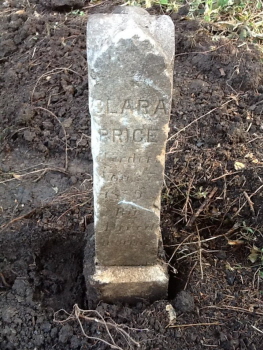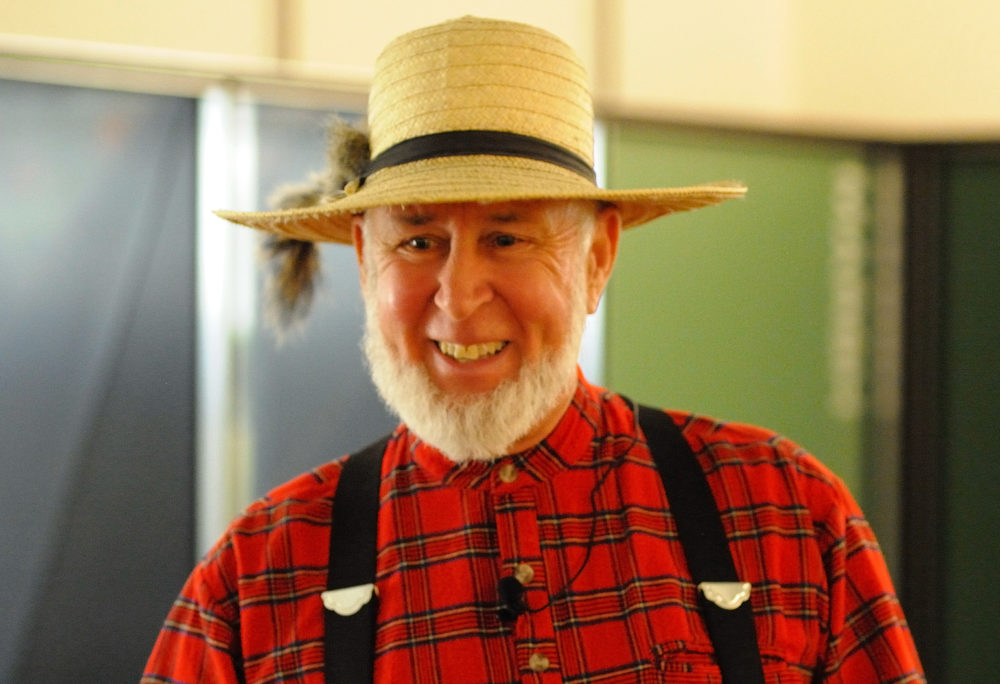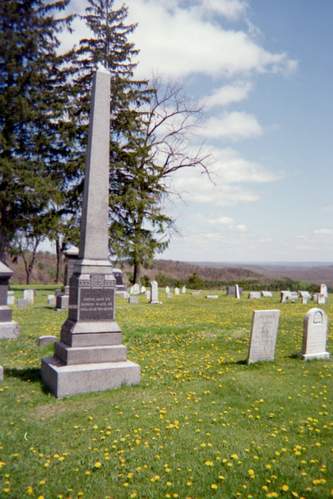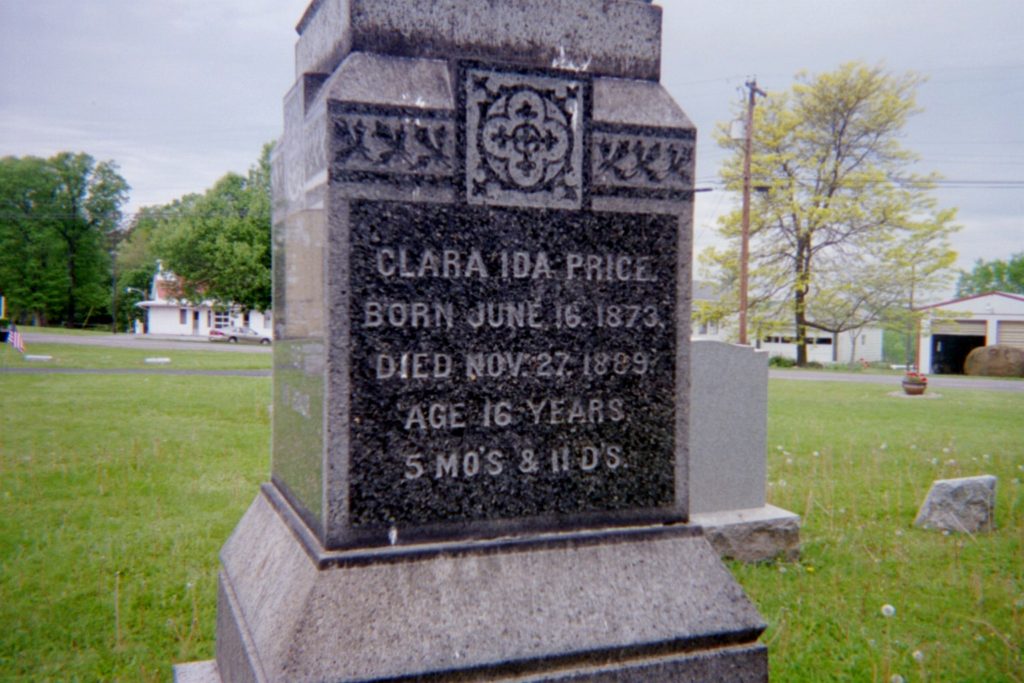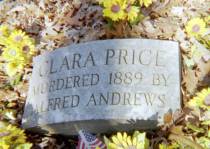
“It was on the road to Karthus, upon that fateful morn, never thinking for a moment that she never would return. But cruel fate was sore against her, and there she had to die, not even having opportunity to bid her friends goodbye.”
Clara Price was murdered in 1889 by a man named Alfred Andrews. It says so on a granite stone that sits by the side of the road in far-western Centre County. The stone is located along PA Route 879 between Snow Shoe and Karthaus PA. It is about a half-mile east of the bridge over the West Branch of the Susquehanna River in Burnside Township, Centre County. Although it sits facing the road, about three feet from the asphalt so as to be easily read by passers-by, most travelers zoom by at fifty miles an hour and never notice it. Like them, I too had been driving by that stone for years when one day it caught my eye. Since then, I’ve stopped to read it many times, often scraping away the leaves and fallen twigs. Who was she I’ve wondered? Is it her tombstone? My curiosity finally prompted me to seek out Clara’s story.
Let’s start with Wednesday May 9, 1890, although that may be considered the end of the story. The day dawned gray and overcast, and although it was well into spring, there was a cool damp to the air that let you know winter hadn’t been left that far behind. It was a good day for a hanging. Alfred Andrews didn’t think so, but it didn’t matter what Andrews thought, because his Centre County trial had found the young Englishman guilty of murder. Judge Austin O. Furst had sentenced him to death with the following words, “The sentence of the law is that you, Alfred Andrews, the prisoner at the bar, be taken hence to the jail of Centre county, and from thence to the place of execution, designed by law, and that you there be hanged by the neck until you are dead, and may God have mercy upon your soul.” A large throng had gathered there in the county seat town of Bellefonte to see the sentence carried out. The restaurants and taverns of the town found business nicely brisk. Except for maybe a circus, there was nothing like a hanging to bring out the crowd.
“Now Andrews is convicted, his death warrant is now here, and he must rue that fatal day, and his knees should quake with fear. On the ninth of April next, ‘Tween the hours of 10 and 3, the friend will have to pay his debt, upon the gallows tree.” This bit of rhyme and the opening one of this story were written by Hugh McGrath, a jailhouse poet who was a prisoner in the Centre County jail at the time Andrews was awaiting his execution. The entire poem appeared in the January 26, 1939, Bellefonte Centre Democrat newspaper, which ran a several part series on the crime.
The procession started from the cell to the scaffold at 10:40 o’clock. Two clergymen, Sheriff Robert Cooke, and several deputies accompanied Alfred on his last walk. He mounted the steps, faced the assembled throng, and asked for a glass of water. He then spoke a few words of remorse for his actions, concluding with, “I am sorry I took the life of that girl, and I hope to meet her in heaven.” The black cap was adjusted over his head, and after a momentary pause, the trap door was sprung. In only a few moments, Alfred Andrews hung motionless, dead of a broken neck. Three physicians then testified to “the extinction of life.” His final resting place is unknown. It is supposed to be “on the ridges back of Milesburg,” as local cemeteries refused to accept his body.
Now you know the end of the story. To find its beginnings, we go back to November 27, 1889, the day before Thanksgiving. The scene is the road from Pine Glen to Karthaus. Today it is state route 879; back then it was just a dirt path wide enough for wagons. Three men from Snow Shoe were heading on foot for a hunting camp just west of Karthaus. Approaching the river, the road is steep and heavily wooded. James Marsteller, William Oswalt, and Jacob Beechdel came across the body of a young woman, sprawled in the muddy road. She had been shot several times. At least one of the bullets had gone through her back. An autopsy showed that the bullet had severed the pulmonary artery which was likely the cause of death. Other reports said she was shot in the head, neck, and through the heart. Signs of struggle at the scene, mostly footprints, seemed to show that after being accosted Clara had tried to flee before she was shot. The three men alerted the authorities in Karthaus and investigation into the crime commenced. The prosecution would later contend that Clara had been sexually assaulted prior to her death. As it would turn out, Clara was the victim of circumstance. She was simply in the wrong place at the wrong time. The photo below, from a Centre County source, is believed to be of Clara.
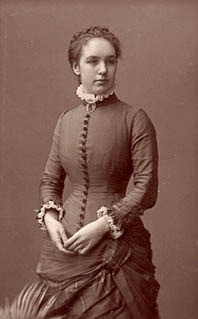
Clara was the daughter of David and Margaret Price of Karthaus. She had been staying for a few days with a friend, a Mrs. Meeker, on the Centre County side of the river, while Mr. Meeker, a logger, was away from home. She had set out from the Meeker house, carrying a basket, to return to her home in Karthaus and to shop at the store there. Clara was 16 years old; she was born in June 1873. By various reports she was “a highly respected young lady . . . considered to be one of the most beautiful girls in the place.”

Although the roadside was sparsely populated, and remains so today, several people recalled seeing Clara walking along the road towards the river. One, a Mrs. Watson, distinctly recalled seeing Clara pass by. Mrs. Watson also recalled that Clara was followed only a few minutes later by a man who matched the description of Alfred Andrews. Another witness, Samuel Emerick saw a “young, heavy-set, short, smooth-faced man who wore a derby hat” passing down the road soon after Clara went by. The investigation quickly pointed to Andrews, who had once lived in Karthaus, thus his recognition by neighbors. Police Detective Harry Simler arrested him at his home in Brisbin the Sunday following the murder. A description of Andrews after he was brought to the Bellefonte jail stated “He is of a short stout build and has a light complexion. He wore a black derby hat.”
So who was Alfred Andrews (pictured above) and how did he come to be on the road to Karthaus that fateful morning? Andrews was an Englishman, born March 6, 1868, in the town of Ponsanooth, county of Cornwall. His mother died when he was fourteen months of age, and he was “given in charge of an old lady by the name of Johanna Prisk,” with whom he remained until about age 12. Little more is known about his young life. He came to the United States at age 17. He had been learning the mill wright trade, but admitted to having fled England, not to better his situation, but rather to escape prosecution for various minor crimes, mostly robberies. In his confession statement, he told also of blowing up a powder mill, which caused the death of several people. Andrews was 21 years old at the time of the murder.
Alfred apparently moved around quite often. He testified that after arriving in New York he came on to Altoona where he worked as a coal miner. From there he moved to Lock Haven, then to McKean County for awhile, and then to Pittsburgh. He had lived in Karthaus for a while, but at the time of the murder he lived in Brisbin, Clearfield County, with a wife and child. He continued his thievery after coming to Pennsylvania, stealing whenever the opportunity presented itself. He admitted to having stolen a diamond ring from the daughter of an employer in Lock Haven. While living earlier at Karthaus he also admitted to borrowing a shotgun from a neighbor and then shooting a shote (a young pig) belonging to Thomas White, which he then took home and butchered for his own family’s use. He was an accomplished thief, but he had never yet deliberately killed anyone.
As for November 27, Andrews admitted that he had left home a few days before, setting out to see what he could steal. The morning of the murder, he intended to rob the store in Karthaus. He had followed a peddlar for a while, hoping for a chance to steal his pack, but the opportunity did not present itself. He tried to avoid people seeing him, often hiding in the woods until they passed by. As it turns out, he murdered poor Clara Price to keep her from being able to tell anyone he was on the road there. “The only purpose I had in killing Clara Price was to prevent her from giving information of my being in that part of the country.” Even though Alfred had lived in Karthaus too for a time, did Clara recognize her killer? We will never know. In his later confession, Andrews said, “When I came opposite her, she stepped off the road towards the woods. I asked her name, and she said, ‘Price’s daughter.’ ‘I said Dave Price?’ She answered ‘Yes.’ Then I attempted to chase her into the woods. She then screamed, and I was afraid of being heard, and pulled my revolver and shot, she running towards Mrs. Watson’s. I continued shooting at her emptying my revolver of the five shots.” Testimony from men working in the woods nearby reported hearing five gun shots at the approximate time of the murder.
Andrew’s trial, in the January 1890 session of the Centre County Court, lasted six days. Some sixty witnesses were paraded before judge and jury, but none of them had seen the crime committed. The defense tried to create an alibi for Alfred’s whereabouts at the time of the crime. He was represented by Edward R. Chambers and Col. Jack Spangler, noted local attorneys at the time. They made “two of the most eloquent appeals to the jury on behalf of Andrews that were ever heard in the Centre County Courthouse.” The prosecution on the other hand was conducted by County District Attorney J. C. Meyer, and ex-judge John H. Orvis. “The web of circumstantial evidence woven by Judge Orvis around the prisoner was one of the most convincing arguments ever heard at the Centre County bar.”
One of the important bits of circumstantial evidence at the trial concerned blood that was found on Alfred’s shoes. This was alleged by “two chemical experts” to be human blood. Forensics at the time could not connect it to Clara. Andrews claimed the blood, if any, came from a white rooster he had killed the night before his arrest, stating in court, “I solemnly state that I know of no other way that blood could have got on my shoes.”
The “convincing arguments” won out over the “eloquent appeals”, as the jury, after only two and a half hours of deliberation, found Andrews guilty of the crime. “The jury was polled, each man answering distinctly as his name was called, ‘Guilty.’ During the rendering of the verdict, the prisoner sat as seemingly careless and unconcerned as any of the spectators in the vast audience. . . .”
While incarcerated awaiting his death, Alfred Andrews made the following statements. “I desire to further say that I had a fair and impartial trial, and that I have no reflections against the judges who presided at my trial, the jury who convicted me, or the attorneys for the Commonwealth, as I consider they all performed their duties honestly and conscientiously. I also return thanks to my attorneys for the able manner in which they defended me.”
He continued, “If it was in my power I would restore all that I have taken unlawfully, even to the restoring of the life of Clara Price, which weighs heavily on my mind.” In his pronouncing of the sentence Judge Furst concluded, “You need not expect or hope for a change in the verdict, by an appeal to any earthly tribunal. No constituted authority in the land can read the record of your trial without pronouncing your guilt. There is no appeal left to you but to your God.”
The stone that sits by the road to the river marks the approximate spot where the body of Clara Price was found that fateful day in November 1889. It looks too new for such an old crime. This stone was placed by Burnside Township to replace an earlier one that had disappeared. A local neighbor has lovingly tended this new stone for many years. . Clara’s actual grave is two miles away in the cemetery in Keewaydin, in Covington Township, Clearfield County. “Clara Ida Price” it says. “Born June 16, 1873 Died November 27, 1889 Age 16 years, 5 months, 11 days Murdered near Karthaus PA by Alfred Andrews Virtue Hath Its Rewards In Life, As Well As After Death My Life For My Honor.” This monument, of Quincy granite, cost $318, a significant sum at the time of its unveiling on November 29, 1890, a year and two days after Clara’s death. The funds were contributed by many in the community. A cornerstone in the monument encloses a listing of the subscribers who donated funds, and various papers concerning the murder, the trial, and the execution of Alfred Andrews. Photos of her grave marker are shown below.)
Now you know the story. Jailhouse poet Hugh McGrath concluded his poem: “Now to say in conclusion, For I have encroached upon your time, I hope none are offended with this, my horrid rhyme. But one request I’ll ask of you, Pretty maidens one and all. Pray think a moment of poor Clara’s fate, and how she came to fall.”
A bit of Clara’s story appears in a poem in a poetry book entitled Elizabethan Days by noted early Pennsylvania folklorist Henry W. Shoemaker. The poem includes these words: St. Cloud stops his song, and tells us why, and points to a marble block by the road — “It’s been chipped by travelers, but once it showed In letters plain, like a warning sign — ‘Clara Price, murdered November 27, 1889.’ The poor girl was going to fetch the cows When the — of a — attacked her here; She fought her best, for she knew no fear, But gave her life in this awful spot.”
I am indebted to the friendly staff of the Pennsylvania Room of the Centre County PA library in Bellefonte, PA., for helping me find the following source material from their files: Bellefonte Democratic Watchman – Nov 29, 1889, Feb 7, 1890, Nov. 21, 1890, Bellefonte Centre Democrat – Nov 28, 1889; Dec. 5, 1889; Jan 19, 1939; Jan 26, 1939
The following manuscript from the library files was also most informative. “The Great Crime! Trial and Confession of Alfred Andrews For the Killing of Miss Clara Price” Copyright 1890 by Col. D. S. Dunham
The sketch of Alfred Andrews was found on the following website – www.bellefonte.topcities.com/hangings/page5.html
In a most interesting July 2013 postscript to this story, the original marker stone that stood by the side of PA Route 879 to mark the place where Clara’s body was found was itself unearthed in an overgrown back yard in Coatesville, Chester County, PA. This is a long way from Karthaus, and at this writing no one knows how or why the stone got to Chester County, nor why it was buried there. A photo of this stone is shown below. The one presently by the side of the road replaced the original many years ago. The present stone was apparently placed by a local resident named Hutchinsone following the disappearance of the earlier one shown below. This original stone is now in the possession of Burnside Township.
